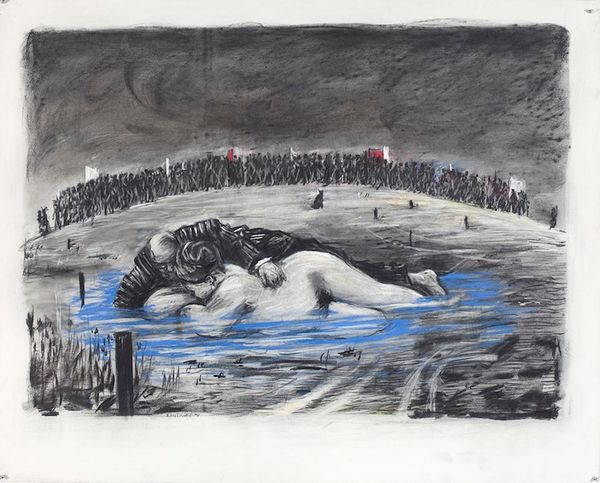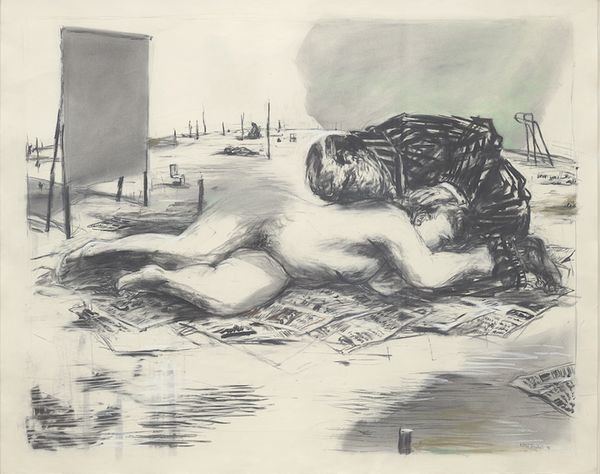William Kentridge, Mr and Mrs Eckstein, 1991. Estimate £160,000 - 200,000. 20th Century and Contemporary Art Day Sale, London.
Mr and Mrs Eckstein, 1991, is a spectacular example of William Kentridge’s politically induced charcoal drawings. Featuring a recurring character in Kentridge’s work, the eponymous Mr. Eckstein, along with his curvaceous wife Mrs. Eckstein, the drawing presents the viewer with the aftermath of a dramatic event, devising a chaotic setting that is typical of the artist’s usually barren environments.
Mr. Eckstein evinces a possible desire for redemption, in the wake of the mayhem caused by his financially motivated actions.
First appearing in the artist’s 1989 animated film Johannesburg, 2nd Greatest City After Paris, Mr. Eckstein (Soho Eckstein) epitomises Kentridge’s vision of a Johannesburg mining magnate, characterised by his greediness and capitalist drive. Yet here, Mr. Eckstein is portrayed kneeling by his wife’s side, leaning over her figure in a protective manner, seemingly kissing her right shoulder and delicately placing his right hand above her head. Depicted in such a warm and empathetic predisposition, Mr. Eckstein evinces a possible desire for redemption, in the wake of the mayhem caused by his financially motivated actions.
The land upon which the two figures lay furthermore elicits powerful metaphoric associations. Arid, lifeless and burned, the environment is haloed by a cloud of smoke that seems to evaporate in the background, leaving nothing but calcined tree trunks and what appears to be a school board. Together, these erasures symbolise a torn nation as well as the challenges required to repair collateral casualties. In this perspective, the landscape becomes a possible symbol for the irreparable damage caused by the mining industry in Johannesburg. The gestural marks, shadows and smudges furthermore build upon the emotion elicited by this fragile and impermanent atmosphere. In using these marks, Kentridge reinforces the chaotic ambiance of repression which reigned at the time of his drawing, suggesting that the only two survivors are the depicted Mr. and Mrs Eckstein, cocooned at the centre of the composition.

© William Kentridge and Private Collection
Over the course of his artistic practice, Kentridge has often fused artistic production and personal political assertions. As the son of two anti-apartheid lawyers and civil-rights activists, the artist quickly cultivated political motivations of his own, reinforced by his research in African history and politics as a student, prior to becoming an artist. His upbringing would indeed highly influence and inspire themes addressed throughout his oeuvre. Equally, the hybrid artistic genre he devised by combining various media including drawing, theatre production, and film rendered his art alive, vibrant, and relevant.
With his animated charcoal films specifically, Kentridge was able to share his own insights regarding the segregated world he grew up in.
With his animated charcoal films specifically, Kentridge was able to share his own insights regarding the segregated world he grew up in—a universe often foreign to his Western audience. The wounds caused by this period in South Africa are what inspired most of his work. As such, Mr and Mrs Eckstein is a beautiful example of the artist’s fusion between artistic production and personal political assertions.
Discover More from the 20th Century and Contemporary Art Day Sale >

Recommended Reading
In Conversation with Allen Jones >
Haring, Condo and Basquiat Masterworks to Benefit the Bedari Foundation >
